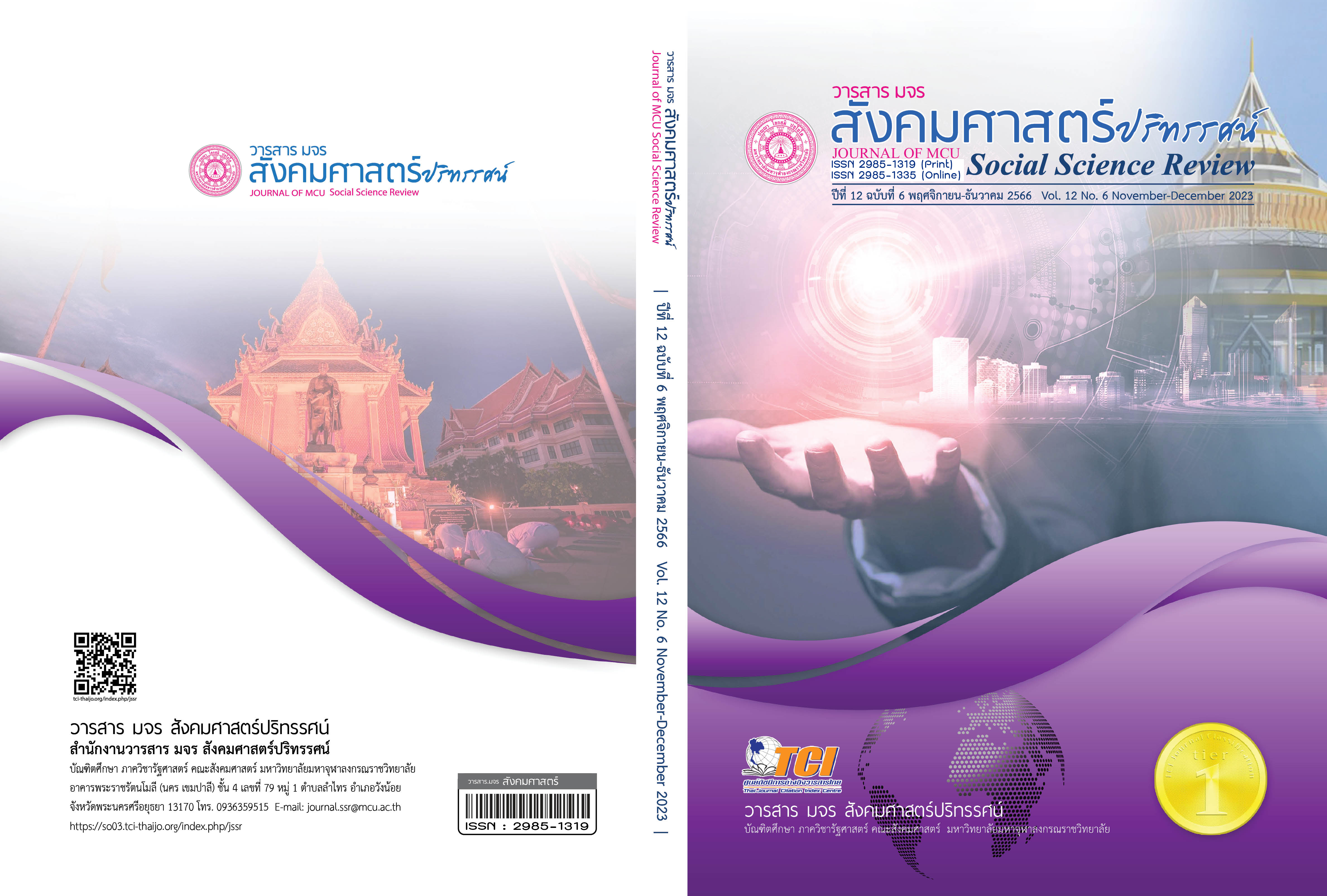การจัดการสภาพแวดล้อมและภาวะวิกฤตหนองบัวพระเจ้าหลวง อำเภอดอยสะเก็ด จังหวัดเชียงใหม่
คำสำคัญ:
การจัดการสภาพแวดล้อม, ภาวะวิกฤต, การบริหารจัดการน้ำ, หนองบัวพระเจ้าหลวงบทคัดย่อ
บทความวิจัยนี้มีวัตถุประสงค์ 1. ศึกษารูปแบบการจัดการทรัพยากรน้ำของชุมชนและภาคีเครือข่าย ต้นน้ำ กลางน้ำ ปลายน้ำ 2. ศึกษากระบวนการมีส่วนร่วมของชุมชนต่อการจัดการสภาพแวดล้อมและภาวะวิกฤตในพื้นที่หนองบัวพระเจ้าหลวง 3. สร้างเครือข่ายการจัดการทรัพยากรน้ำในพื้นที่หนองบัวพระเจ้าหลวง อำเภอดอยสะเก็ด จังหวัดเชียงใหม่ รูปแบบวิธีการวิจัยใช้ระเบียบวิธีวิจัยเชิงปฏิบัติการแบบมีส่วนร่วม (Action Research)
ผลการวิจัยพบว่า 1. การจัดการทรัพยากรน้ำโดยสร้างการรับรู้จากประสบการณ์ในการพัฒนาพื้นที่ 2. กระบวนการมีส่วนร่วมตั้งแต่การร่วมคิด ร่วมทำ และร่วมรับผลประโยชน์ พัฒนาอนุรักษ์ ฟื้นฟู และใช้ประโยชน์อย่างเหมาะสม ด้วยการบำรุงดูแลรักษาแหล่งน้ำอย่างสม่ำเสมอ ด้วยเทคนิค 3Rs คือ การลด (Reduce) การใช้ซ้ำ (Reuse) การรีไซเคิล (Recycle) เช่น กิจกรรมเทน้ำปุ๋ยหมักชีวภาพ (EM) และกังหันน้ำเพื่อเพิ่มออกซิเจนในน้ำ ทุกกิจกรรมผ่านการมีส่วนร่วมตั้งแต่การค้นหาปัญหา วางแผน ตัดสินใจ และติดตามประเมินผล เพื่อให้เกิดความยั่งยืน และบรรลุเป้าหมายที่กำหนดไว้ การทำงานต้องจัดการสภาพแวดล้อมด้วยระบบเครือข่ายบริหารจัดการเชิงสาธารณะ 3. สร้างเครือข่ายในระดับพื้นที่ของกลุ่มผู้ใช้น้ำ จัดทำนโยบาย มาตรการ การบริหารจัดการน้ำหนองบัวพระเจ้าหลวง อนุรักษ์ ฟื้นฟู ตลอดจนทำ MOU ร่วมกันกับภาคีเครือข่าย
เอกสารอ้างอิง
กลุ่มงานยุทธศาสตร์และข้อมูลจังหวัด. (2565). แผนพัฒนาจังหวัดเชียงใหม่ (พ.ศ. 2561-2565) ฉบับทบทวนรอบปี พ.ศ. 2565. เชียงใหม่: สำนักงานจังหวัดเชียงใหม่.
ชนันธร บัวสุข และคณะ. (2559). การเสริมสร้างภาวะผู้นําชุมชนในการพัฒนาและถ่ายทอดภูมิปัญญาด้านการจัดการทรัพยากรน้ำอย่างยั่งยืน : กรณีศึกษาบ้านเมืองงาย ตำบลเมืองงาย อำเภอเชียงดาว จังหวัดเชียงใหม่. วารสารมหาวิทยาลัยราชภัฏลําปาง, 5(2), 33-44.
เดลินิวส์. (2566). เตรียมทำพื้นที่รอบหนองบัวพระเจ้าหลวง'เป็นจุดท่องเที่ยว. สืบค้น 1 มิถุนายน 2565, จาก https://d.dailynews.co.th/article/640512/
ปรมินทร์ นาระทะ และศันสนีย์ กระจ่างโฉม (2020). การมีส่วนร่วมในการจัดการทรัพยากรน้ำของเกษตรกรชาวนาในพื้นที่ปลูกข้าวหลักของจังหวัดเชียงใหม่. วารสารวิจัยราชภัฏเชียงใหม่, 21(3), 155-173.
มนูญ มนูขจร และคณะ. (2020). รูปแบบถ่ายทอดการบริหารจัดการทรัพยากรน้ำชุมชนเพื่อสิ่งแวดล้อมอย่างยั่งยืนจังหวัดบุรีรัมย์. วารสารการบริหารนิติบุคคลและนวัตกรรมท้องถิ่น, 7(1), 287-302.
มานะ ขุนวีช่วย. (2556). บทสังเคราะห์ชุดโครงการวิจัยความรู้ และการจัดการน้ำของคนนครศรีธรรมราช (รายงานการวิจัย). นครศรีธรรมราช: มหาวิทยาลัยราชภัฏ นครศรีธรรมราช.
มิวเซียมไทยแลนด์. (2565). หนองบัวพระเจ้าหลวง หนองน้ำธรรมชาติ. สืบค้น 1 มิถุนายน 2565, จาก https://www.museumthailand.com/
สำนักงานคณะกรรมการพัฒนาการเศรษฐกิจและสังคมแห่งชาติ. (2561). ยุทธศาสตร์ชาติ พ.ศ. 2561-2580. กรุงเทพฯ: สำนักงานเลขานุการของคณะกรรมการยุทธศาสตร์ชาติ.
อเนก ธรรมาธิวัฒน์. (2555). การมีส่วนร่วมของชุมชนในการจัดการน้ำของจังหวัดเพชรบูรณ์ตามแนวปรัชญาเศรษฐกิจพอเพียงอย่างยั่งยืน (รายงานการวิจัย). เพชรบูรณ์: มหาวิทยาลัยราชภัฏเพชรบูรณ์.
Tripinchiangmai. (2565). ทริปนี้ที่เชียงใหม่ หนองบัวพระเจ้าหลวง. สืบค้น 1 มิถุนายน 2565, จาก https://shorturl.asia/V4lGe
ดาวน์โหลด
เผยแพร่แล้ว
รูปแบบการอ้างอิง
ฉบับ
ประเภทบทความ
สัญญาอนุญาต
ลิขสิทธิ์ (c) 2023 วารสาร มจร สังคมศาสตร์ปริทรรศน์

อนุญาตภายใต้เงื่อนไข Creative Commons Attribution-NonCommercial-NoDerivatives 4.0 International License.
เพื่อให้เป็นไปตามกฎหมายลิขสิทธิ์ ผู้นิพนธ์ทุกท่านต้องลงลายมือชื่อในแบบฟอร์มใบมอบลิขสิทธิ์บทความให้แก่วารสารฯ พร้อมกับบทความต้นฉบับที่ได้แก้ไขครั้งสุดท้าย นอกจากนี้ ผู้นิพนธ์ทุกท่านต้องยืนยันว่าบทความต้นฉบับที่ส่งมาตีพิมพ์นั้น ได้ส่งมาตีพิมพ์เฉพาะในวารสาร มจร สังคมศาสตร์ปริทรรศน์ เพียงแห่งเดียวเท่านั้น หากมีการใช้ภาพหรือตารางหรือเนื้อหาอื่นๆ ของผู้นิพนธ์อื่นที่ปรากฏในสิ่งตีพิมพ์อื่นมาแล้ว ผู้นิพนธ์ต้องขออนุญาตเจ้าของลิขสิทธิ์ก่อน พร้อมทั้งแสดงหนังสือที่ได้รับการยินยอมต่อบรรณาธิการ ก่อนที่บทความจะได้รับการตีพิมพ์ หากไม่เป็นไปตามข้อกำหนดเบื้องต้น ทางวารสารจะถอดบทความของท่านออกโดยไม่มีข้อยกเว้นใดๆ ทั้งสิ้น





